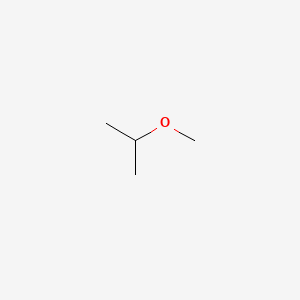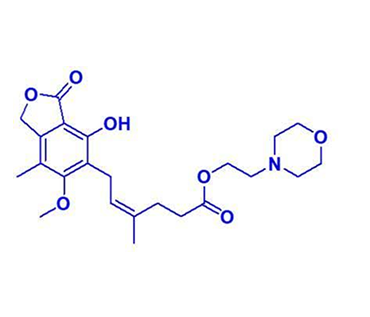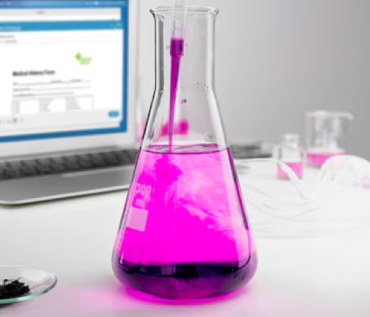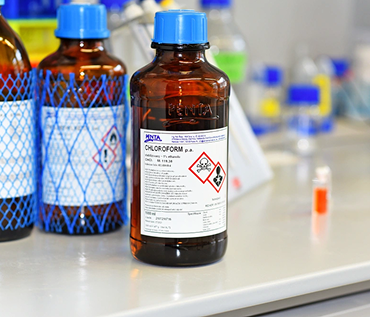Methyl Isopropyl Ether, called 2-Methoxypropane as per the IUPAC system, is a simple aliphatic ether. It is a colourless liquid ether with molecular formula C₄H₁₀O. Since it has a low boiling point of 31-32oC, it quickly vaporizes, making it one of the most challenging ethers to handle. Its physical and chemical properties are similar to the other homologues in the series, making the separation and purification process an ardent task.
This ether is slightly soluble in water but readily dissolves in organic solvents, thus making it a valuable solvent in the pharmaceutical and chemical industries.
Chemical Properties and Composition
Molar Mass: 74.12 g/mol
Structural Formula: CH₃-O-CH(CH₃)₂. The Methoxy group is attached to an isopropyl grup.
Hydrogen Bond Donor Count: 0
Hydrogen Bond Acceptor Count: 1
Reactivity: Stable under normal conditions. When exposed to air and light for extended periods, it forms peroxides, which can be explosive.
Functional Group: Ether (-O-)
Hybridization: The oxygen atom in this compound is in a sp³ hybridized state responsible for creating a bent molecular shape.
Key Applications in the Specialty Chemicals Industry
Owing to its low polarity, high volatility and hydrophobic nature, 2-Methoxypropane is used in the following manner:
Used as Solvent in Organic Synthesis: It is used in Grignard Reactions and organometallic processes because of its compatibility with reactive intermediates. It is also an ideal solvent for extracting non-polar compounds in labs and industries. 2-Methoxypropane, in the presence of an acid catalyst, reacts with diols to form acetonide-protecting groups, thus protecting the diol’s functionality during the subsequent reactions.
Acts as an Additive: It is used as an oxygenate additive in gasoline formulations, improving combustion efficiency. The solvent is used in synthetic lubricants because of its solvency properties and stability.
Pharma and Chemical Industries: It serves as an intermediate in synthesising APIs (Active Pharmaceutical Ingredients). This compound is only soluble in organic solvents, so it is used in purification and crystallization processes. Its high volatility makes it a suitable solvent for drug formulation.
Manufacturing of Polymers and Resins: 2-Methoxypropane acts as a chain transfer agent in polymerization, especially in acrylics and polyurethanes. The solvent is also used as a diluent in resin formulations for coatings, adhesives, and sealants. It also improves the film formation and drying properties of the industrial coatings.
Agrochemical Industry: Isopropyl methyl ether acts as a carrier solvent in pesticide and herbicide formulations. It enhances its application efficiency since it improves the pesticide’s solubility and stability.
Safety Guidelines for Handling and Storage
Isopropyl methyl ether is a highly volatile and flammable ether, so it must be handled carefully. Here are the safety guidelines to be followed:
How to Handle 2-Methoxypropane?
Wear nitrile or butyl rubber gloves to prevent skin contact. Use Safety goggles or a face shield to protect against splasher. If inhaled excessively, use an organic vapor respirator. Wear lab coats while handling this solvent. Use this solvent in a well-ventilated area; using it under a fume hood is advised to prevent vapor inhalation. While handling this solvent, keep it away from open flames and hot surfaces, as it is a flammable liquid.
How to Store 2-Methoxypropane?
This solvent must be stored in light-resistant containers to avoid peroxide formation. It must be stored in a cool(below 25°C) and dry place. Store in a tightly sealed and properly labelled container, or use the nitrogen purging method to avoid peroxide formation. You can store it in stainless steel, aluminum, or fluoropolymer-lined containers.This solvent can cause the degradation of rubber, plastics or reactive metals if exposed for prolonged periods. Isopropyl methyl ether must be kept away from Strong oxidizers such as peroxides and nitric acid to avoid explosive reactions, Acids and Bases to avoid acceleration of decomposition, and Halogens to prevent hazardous reactions.
Safety Measures
In case of a fire, DO NOT use water to extinguish it, as it may spread fire. Instead, use Carbon Dioxide or foam extinguishers. Evacuate the place immediately and follow the emergency fire response protocols. In case of a small spill, absorb this solvent using inert materials like sand and vermiculite and dispose of it safely.In case of a large spill, evacuate the place, ensure it is well-ventilated, and use spill containment kits. Since this chemical is a hazardous solvent, do not throw it away in drains, as it may enter sewers, waterways or soil, leading to contamination.
First Aid Measures
If Isopropyl methyl ether is inhaled excessively and the person feels dizzy and suffers a headache, nausea, and difficulty breathing, move the person to fresh air immediately. Also, seek medical attention if breathing difficulties persist. If it is exposed to the skin and causes irritation, redness, and dryness, wash the exposed area with soap and water for at least 15 minutes.Remove contaminated clothing and look for medical advice if the irritation continues. If the solvent comes in contact with the eyes and causes redness, burning and watering eyes, flush your eyes with clean water for at least 15 minutes. If the symptoms still exist, seek medical help.
In case of accidental ingestion of Isopropyl methyl ether, do not induce vomiting as it can cause the solvent’s aspiration into the lungs. Rinse your mouth, drink water or milk if conscious, and seek medical help immediately.
How to Dispose of 2-Methoxypropane?
Follow local hazardous waste regulations to discard the waste and contaminated materials. Incineration is a preferred method to dispose of waste.
Where to buy Isopropyl methyl ether?
Isopropyl methyl ether, also known as 2-methoxypropane, due to its similarity with other homologues in series, is challenging to separate and purify this solvent.
At Advent, we develop this solvent in Mg to G scale with more than 95% purity and are being serviced to esteemed Pharma customers in domestic and overseas markets as a Working Standard with all characterization data such as 1H NMR, Mass, IR, and more.





